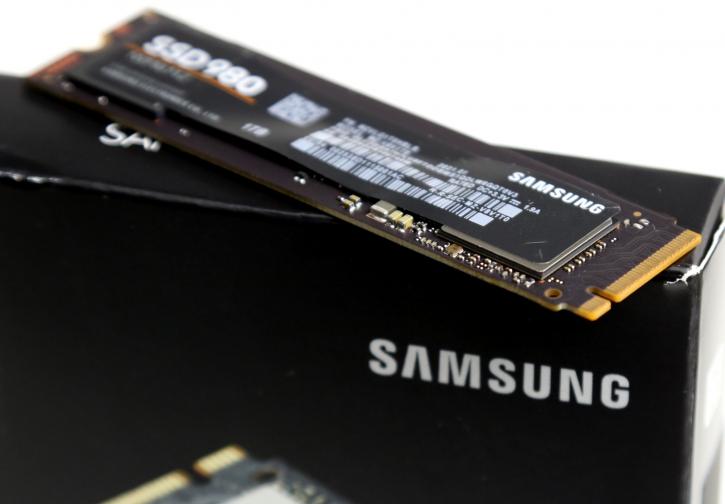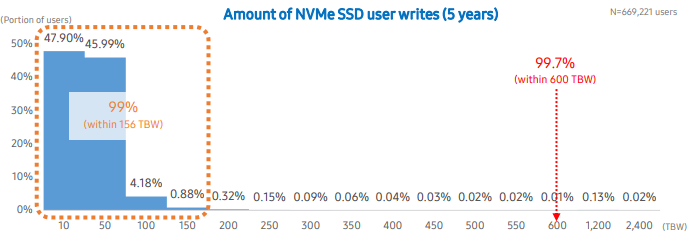Specifications & Features
Specifications & Features
The sample that has arrived for testing is the 1TB version of the drive. The series, as stated, will be fitted with 128-layer TLC written (3-bits per cell) 3D NAND flash memory (vertically stacked). As mentioned, Samsung is listing this at MLC, but when you write 3-bits per NAND cell, really that is TLC. So instead of using Planar NAND, 3D NAND is used. 3D TLC NAND is a physical vertical NAND cell stacking not to be confused with chip stacking in a multi-chip package. In 3D NAND, NAND layers, not chips, are stacked in a single IC. The good news is continued cost reduction, smaller die sizes, and more capacity per NAND chip. Also, installed NAND toolsets in the wafer fabs can, for the most part, be reused, thereby extending the useful life of fab equipment. A Samsung controller drives the NAND ICs, there is a DRAM cache as well as SLC provisioning. There will be 250 GB, 500 GB, and 1 TB versions. Listed below are performances, sequential read and write speeds are listed at 3500 MB/s and 3000 MB/s, respectively. Samsung is pitching 4KB random read speeds of up to half a million IOPS in the best circumstances with the 1TB model. The NAND storage store methodology for the 980 is TLC based (so three bits per cell written), and not MLC.
Endurance
A cumbersome hindrance with the product series is that Samsung over time has lowered the endurance levels of their NVMe SSDs. Ther 980 is listed as being 600 terabytes written for the 1 TB model (TBW), a value that would be 1200 TBW for the 970 Pro; it is even less than the 960 Pro, which was listed at 800 TBW. With a warranty of 5 years or the respective TBW value depleted, you should see this puppy last a while, though. A study based over more than half a million users shows that in five years you will have written less than 156 TB, which goes for 99% of the consumers.
While we feel 600 TBW is okay, we also need to realize that such a TBW value for a generic consumer is not an issue. If you write 50GB of data each and every day in a year, that's 18.25 TBW per year. 600:18.25 TB = almost 33 years of lifespan. That said, the endurance would matter far greater for video editing platforms and servers. Please do realize that smaller storage sizes have an adverse effect here; the 500GB unit would get 16 Years of lifespan, the 250GB version just six. Ergo, we cast some doubt about the 250GB model and heavy workload utilization.
Controller
Controller with Host Memory Buffer
The 980 NVMe SSD Series is produced to become a cost-effective, high-performance SSD. As such the PCIe-to NAND controller manages a full PCIe Gen 3 (8Gb/s) x 4 bandwidth with the host while managing multiple NAND flash memory devices on (we assume) 4 channels. Combined with the Windows 10 Fall Creators Update 2018 and later you are compatible with Host Memory Buffer technology, your system memory substitutes the memory of the drive to cache the map table. Thus not using DRAM SSD cached equals a nice price reduction. The 980 has adopted this DRAMless architecture. HMB leverages Direct Memory Access (DMA) functionality of the PCI-Express interface so that the SSD can operate even without its own DRAM by using the part of the DRAM memory (64MB) at the system CPU.
Pricing
With the 980 series, Samsung will start off with three models:
- 250GB : £45.99 / 51 EUR
- 500GB: £64.49 / 74 EUR
- 1TB: £119.49 / 139 EUR
The MSRP of the 1TB version is set at 139 EUR/USD. That is slightly on the high side at 13~14 cents per GB.
TurboWrite has been updated up to 160 GB
980 features enhanced Intelligent TurboWrite 2.0 technology. Compared to the previous Intelligent TurboWrite, Intelligent TurboWrite 2.0 provides a larger buffer (TurboWrite region)=(your pSLC buffer). In most cases you can achieve high performance of SLC speed up to 3500MB/s for a longer period of time. The Intelligent TurboWrite algorithm does not affect SSD endurance, because the total amount of data users write on the SSD is unchanged.
The Intelligent TurboWrite region takes advantage of idle capacity that is available and it can dynamically alter that pSLC buffer, so if the SSD does not enough free space, intelligent TurboWrite will not fully operate. This algorithm does not affect SSD endurance because the total amount of data users write on the SSD is unchanged. here again, bigger volume sizes are better.




